pdf basic massage techniques
Massage therapy involves manipulating soft tissues to promote relaxation and wellness. Essential techniques like effleurage and Swedish massage are foundational, offering benefits for both beginners and experienced practitioners.
What is Massage Therapy?
Massage therapy is the manipulation of soft tissues through techniques like effleurage, petrissage, and tapotement. It promotes relaxation, reduces pain, and improves circulation. Derived from the Arabic word “mass” meaning “to press,” it is practiced globally, with Swedish massage being a cornerstone. This therapy is performed by trained professionals to enhance physical and mental well-being, making it a popular holistic practice for various needs.
History and Evolution of Massage
Massage has a rich history spanning thousands of years, with roots in ancient civilizations like Egypt, China, and Rome. Early practices incorporated manual techniques for therapeutic benefits, evolving over time. Swedish massage, developed by Per Henrik Ling, became a cornerstone of modern techniques. Today, diverse methods like Thai yoga and deep tissue massage continue to emerge, blending traditional practices with contemporary advancements to address various health needs and enhance overall well-being.
Benefits of Learning Basic Massage Techniques
Learning basic massage techniques offers numerous benefits, including enhanced relaxation, reduced muscle tension, and improved circulation. It fosters emotional well-being by promoting deep relaxation and stress relief. Regular massage practice can also strengthen relationships through therapeutic touch and communication. Additionally, it provides a natural way to alleviate pain and discomfort, making it a valuable skill for self-care and helping others. These techniques are accessible to everyone, offering a holistic approach to health and well-being, making them an excellent addition to any personal or professional routine.
Essential Massage Techniques for Beginners
Mastering basic techniques like effleurage, petrissage, and tapotement provides a solid foundation for relaxation, easing muscle tension, and improving circulation, perfect for newcomers to massage therapy.
Effleurage: The Foundation of Massage
Effleurage is a foundational massage technique characterized by long, flowing strokes using the palms. It promotes relaxation, improves circulation, and prepares muscles for deeper work. Gentle and rhythmic, it helps reduce stress and tension while creating a soothing connection between therapist and client. Often used as the opening stroke, effleurage sets the tone for the session and allows for an assessment of muscle tone, making it an essential skill for beginners to master in basic massage techniques.
Petrissage: Kneading Techniques
Petrissage involves kneading and lifting soft tissues to release tension and improve circulation. Using the fingers, palms, or thumbs, this technique targets muscle groups, enhancing flexibility and relaxation. It helps break down adhesions and reduces muscle spasms. Typically applied to larger areas like the thighs, back, and shoulders, petrissage promotes deep tissue release. The pressure can be adjusted to suit individual needs, making it a versatile and effective method for addressing muscle stiffness and enhancing overall massage results.
Tapotement: Rhythmic Percussion
Tapotement is a dynamic massage technique involving rhythmic percussion strokes, such as tapping, cupping, or hacking. It stimulates muscles, enhances circulation, and aids in relaxation. Performed with fingertips or palms, it creates a soothing vibration. Common strokes include cupping, hacking, and pincement. Tapotement is often used on larger muscle groups like the back, thighs, and buttocks. It energizes the body, improves lymphatic drainage, and reduces muscle stiffness. Adjusting pressure and rhythm can tailor the technique to individual needs, making it versatile and effective for various therapeutic goals.
Vibration and Pressure Techniques
Vibration and pressure techniques are advanced methods used to target specific areas, enhancing muscle relaxation and circulation. Vibration involves gentle, oscillating movements applied with fingertips or palms to release tension. Pressure techniques, like sustained holds or deep strokes, focus on relieving chronic pain by addressing deeper tissue layers. These methods require precision to avoid discomfort. When applied correctly, they improve joint mobility, reduce muscle spasms, and break down scar tissue. Proper training is essential to master these techniques safely and effectively for therapeutic benefits.
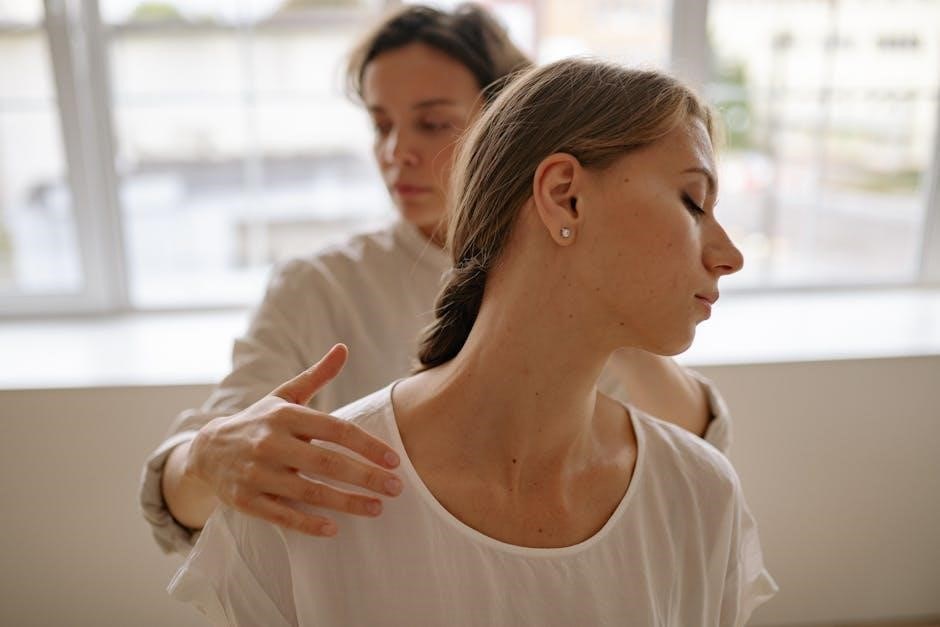
Swedish Massage: Core Concepts
Swedish massage combines long strokes, kneading, and tapping to promote relaxation, improve circulation, and ease muscle tension, forming the foundation of modern massage therapy practices worldwide.
Understanding Swedish Massage Strokes
Swedish massage employs a series of strokes, including effleurage (long gliding movements), petrissage (kneading), tapotement (rhythmic tapping), and vibration. These techniques are designed to relax muscles, improve blood flow, and reduce tension. Effleurage warms up the tissue, while petrissage targets deeper muscle layers; Tapotement stimulates nerves and muscles, enhancing circulation. Vibration aids in releasing muscle spasms. Together, these strokes create a balanced, therapeutic experience, making Swedish massage a cornerstone of modern massage therapy. Proper technique ensures safety and effectiveness, providing relief from stress and pain. Regular practice enhances skill and precision.
Longitudinal Strokes for Relaxation
Longitudinal strokes are fundamental in Swedish massage, involving gliding movements along the length of muscles. These strokes promote relaxation by stretching soft tissues and improving circulation. Applied with varying pressure, they ease muscle tension and enhance flexibility. Longitudinal strokes are particularly effective on the back, legs, and arms, creating a soothing rhythm that calms the nervous system. Regular use of these strokes can reduce stress, improve posture, and leave the body feeling rejuvenated. Proper technique ensures maximum comfort and therapeutic benefits, making them a cornerstone of massage therapy for relaxation and wellness.
Transverse Strokes for Muscle Tension
Transverse strokes, also known as cross-fiber strokes, are used to address muscle tension by applying pressure perpendicular to muscle fibers. This technique helps break up adhesions and knots, improving circulation and reducing stiffness. Often used in areas like the neck, shoulders, and lower back, transverse strokes are effective for chronic tension. When applied with controlled pressure, they can release deep-seated muscle strain, promoting relief and restoring normal muscle function. Regular use enhances flexibility and reduces discomfort, making them a valuable tool in massage therapy for targeted muscle relaxation and rehabilitation.
Deep Tissue and Sports Massage targets deeper muscle layers and connective tissue. It uses slow, deliberate strokes to relieve chronic pain and improve mobility in athletes.
Targeting Deep Muscle Layers
Deep tissue massage focuses on reaching deeper muscle layers and connective tissues. Slow, deliberate strokes apply pressure to areas of chronic pain or tension. This technique helps break down scar tissue and adhesions, improving blood flow and mobility. Common areas targeted include the neck, lower back, and IT band. While it can be intense, deep tissue work is highly effective for long-term pain relief and recovery, especially for athletes or those with chronic conditions.
Techniques for Sports Injuries
Sports massage incorporates specialized techniques to address injuries, focusing on areas of muscle strain or overuse. Kneading and myofascial release help reduce muscle tension and scar tissue. Stretching techniques improve flexibility and range of motion, while targeted pressure points alleviate pain. Using tools like foam rollers or massage balls can enhance recovery. Regular massage promotes blood flow, reducing inflammation and accelerating healing. It’s particularly beneficial for athletes, offering both preventive care and post-injury rehabilitation to maintain performance and overall well-being.
Stretching and Flexibility Exercises
Stretching and flexibility exercises are integral to massage therapy, enhancing range of motion and reducing muscle stiffness. Static stretches, held for 20-30 seconds, improve flexibility, while dynamic stretches promote blood flow. Incorporating stretching after massage maximizes relaxation and prevents muscle imbalances. Techniques like hamstring and quadriceps stretches are effective for common tight areas. Regular stretching improves posture, reduces injury risk, and complements massage by maintaining muscle health and joint mobility, ensuring long-term benefits for overall physical well-being and athletic performance.
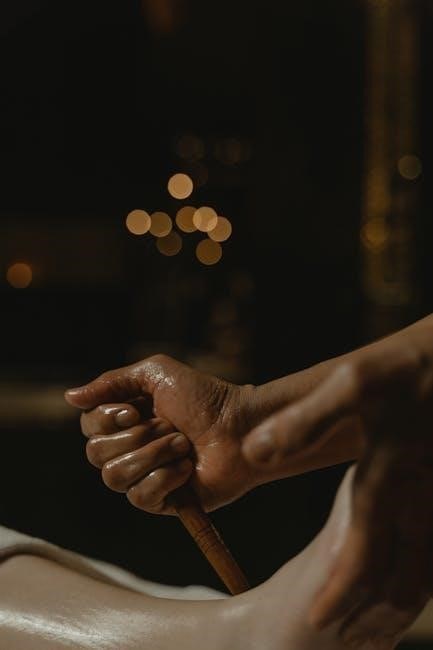
Massage for Specific Needs
Massage can be tailored to address various conditions, from stress relief to chronic pain, enhancing overall well-being. Techniques are adapted to meet individual needs, promoting relaxation and healing.
Massage Techniques for Stress Relief
Massage is a powerful tool for reducing stress by promoting relaxation and calming the mind. Techniques like effleurage, long flowing strokes, and gentle petrissage help ease muscle tension. Focusing on areas such as the neck, shoulders, and scalp can release stored stress. Deep breathing during the session enhances oxygen flow, further calming the nervous system. Regular massage can lower cortisol levels, improve mood, and create a sense of well-being. Incorporating aromatherapy with calming oils like lavender can deepen relaxation, making it an effective stress-relief practice.
Massage for Chronic Pain Management
Massage therapy is highly effective for managing chronic pain by targeting areas of discomfort and improving mobility. Techniques like deep tissue massage and trigger point therapy focus on breaking down adhesions in muscles and connective tissue, reducing pain and stiffness. Slow, deliberate strokes can alleviate tension in areas prone to chronic pain, such as the lower back and joints. Regular sessions can enhance blood flow, reduce inflammation, and promote healing. Massage also helps reduce reliance on pain medications, offering a natural, holistic approach to pain relief and overall well-being. Consistent treatment is key for long-term benefits.
Massage for Improved Circulation
Massage therapy significantly enhances blood flow and circulation by promoting the efficient delivery of oxygen and nutrients to tissues. Techniques such as effleurage (long, gliding strokes) and petrissage (kneading) help dilate blood vessels, improving circulation. This can reduce muscle tension, swelling, and fatigue while boosting overall energy levels. Regular massage also supports lymphatic drainage, aiding in the removal of toxins. Enhanced circulation benefits cardiovascular health, skin tone, and wound healing. Tailored massage routines can address specific circulatory concerns, offering a natural, non-invasive solution to improve overall well-being and vitality.
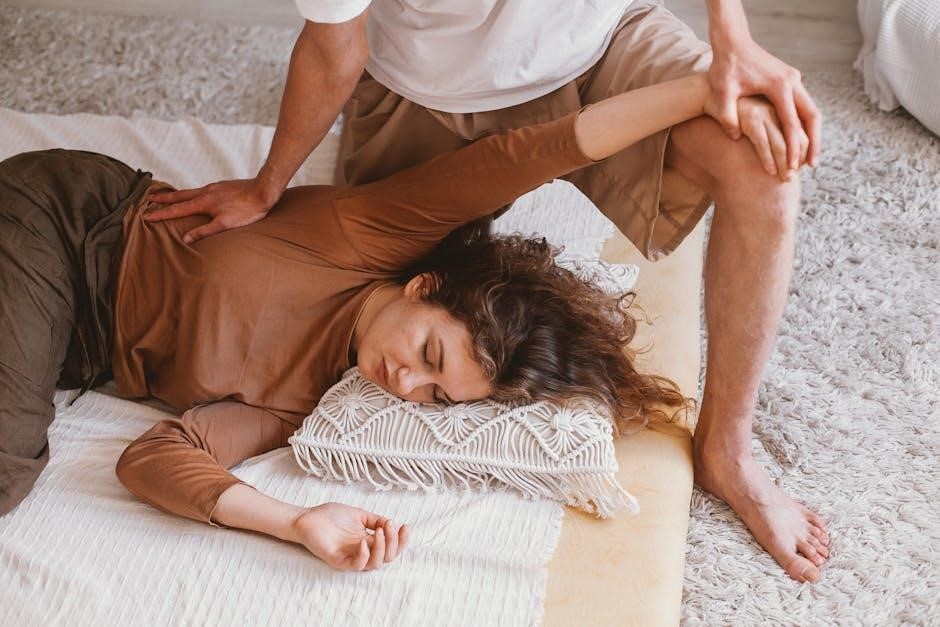
Preparation and Safety
Ensure a clean, private space with necessary tools. Conduct a client consultation to discuss medical history and allergies. Sanitize hands and equipment, and create a calming environment for comfort and safety.
Contraindications for Massage
Massage is not suitable for everyone. Certain conditions, such as acute injuries, severe inflammation, or contagious illnesses, may require avoidance. Areas with open wounds, fractures, or recent surgeries should not be massaged. Conditions like phlebitis, advanced osteoporosis, or severe diabetes with neuropathy also pose risks. Additionally, massage near cancerous tumors or during chemotherapy requires medical clearance. Always consult a healthcare provider before massaging individuals with these conditions to ensure safety and avoid complications.
Creating a Safe Massage Environment
A safe massage environment ensures client comfort and relaxation. Begin by sanitizing equipment and ensuring a clean, clutter-free space. Adjust the massage table height for accessibility and use fresh, laundered linens. Maintain privacy with drapes or screens and regulate lighting for a calming atmosphere. Monitor room temperature and noise levels to enhance relaxation. Encourage open communication, allowing clients to express discomfort or preferences. Always obtain informed consent and respect personal boundaries to foster trust and safety during the session.
Using Massage Oils and Lubricants
Massage oils and lubricants are essential for reducing friction and allowing smooth strokes. They enhance relaxation by gliding effortlessly over the skin. Popular options include sweet almond oil, jojoba oil, and grapeseed oil, each offering unique benefits like moisturizing properties. Always choose oils suitable for the client’s skin type and avoid allergens. Apply a small amount to avoid excess slip, ensuring control during techniques. For those with oil sensitivities, water-based lubricants are a practical alternative. Proper use ensures comfort and effectiveness, making oils a vital tool in massage therapy.
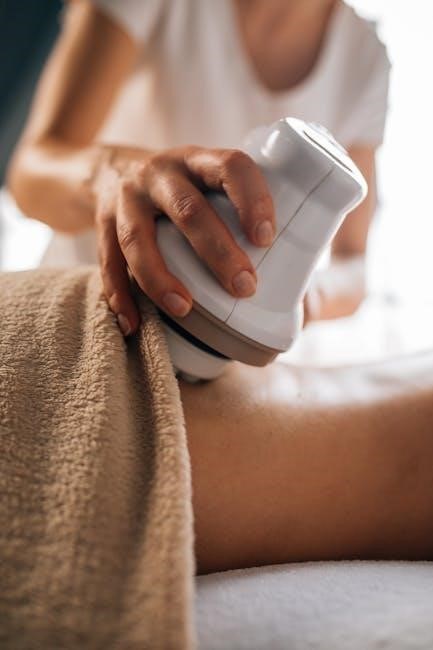
Anatomy and Physiology Basics
Understanding muscle structure, skeletal alignment, and soft tissue function is crucial for effective massage. Knowledge of blood circulation and nerve systems enhances technique accuracy and client safety.
Understanding Muscle Groups
Understanding muscle groups is essential for effective massage. Muscles are categorized into major groups like quadriceps, hamstrings, and deltoids, each serving specific functions. Knowledge of muscle origins, insertions, and actions helps target areas precisely. This understanding improves massage techniques, ensuring pressure is applied correctly. It also aids in identifying muscle imbalances and tension points. Familiarity with muscle groups enhances the ability to customize massage sessions, addressing individual needs and promoting optimal relaxation and recovery. This foundation is vital for both beginners and professionals in massage therapy.
Key Pressure Points and Their Benefits
Key pressure points, such as the solar plexus, sacral area, and Gallbladder 21, offer targeted relief. The solar plexus aids digestion and reduces stress, while the sacral area eases lower back pain. Gallbladder 21 relieves tension headaches and neck stiffness. Applying pressure to these points can improve circulation, reduce muscle tension, and promote relaxation. Understanding these points enhances massage effectiveness, allowing practitioners to address specific discomforts and enhance overall well-being. Regular use of pressure points can lead to long-term health benefits, making them a valuable tool in massage therapy;
The Role of Soft Tissue in Massage
Soft tissue, including muscles, tendons, and ligaments, plays a crucial role in massage therapy. Techniques such as effleurage and petrissage target these areas to relieve tension, improve circulation, and enhance flexibility. Massage stimulates blood flow, reducing inflammation and promoting healing. Soft tissue work also releases fascial restrictions, which can improve posture and reduce pain. Understanding the interconnectedness of soft tissues allows for more effective treatment of common discomforts, such as muscle knots or tightness. Regular soft tissue massage supports overall musculoskeletal health and well-being.
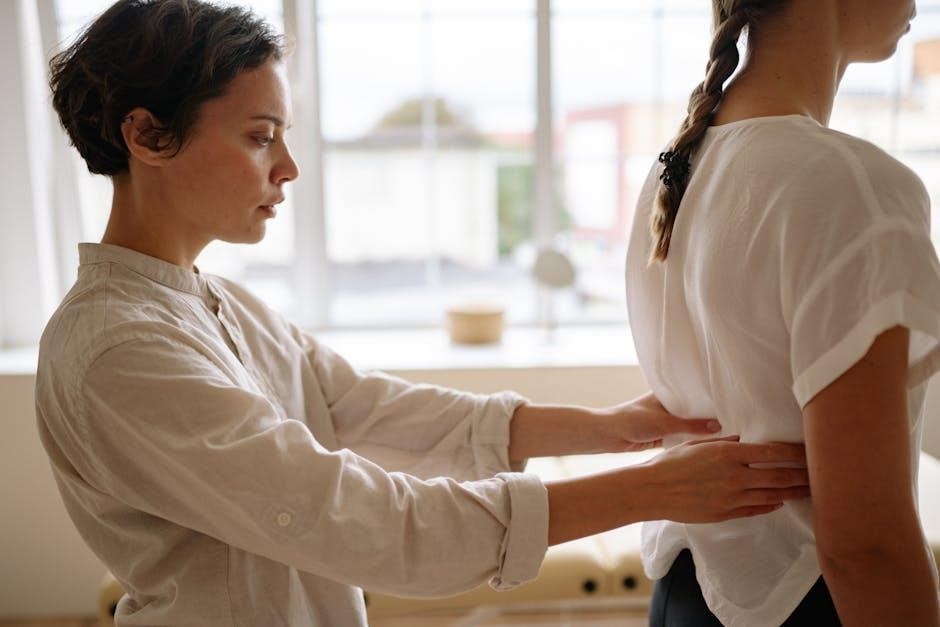
Practical Application of Techniques
Soft tissues, such as muscles, tendons, and ligaments, are central to massage therapy. Techniques like effleurage and petrissage target these areas to relieve tension and improve circulation, reducing inflammation and promoting healing. Regular soft tissue massage enhances flexibility, eases pain, and supports overall musculoskeletal health by releasing fascial restrictions and improving posture. Understanding and working with soft tissues is essential for effective massage practice, addressing common issues like muscle knots and stiffness while fostering relaxation and well-being. Proper technique ensures safe and beneficial outcomes for clients.
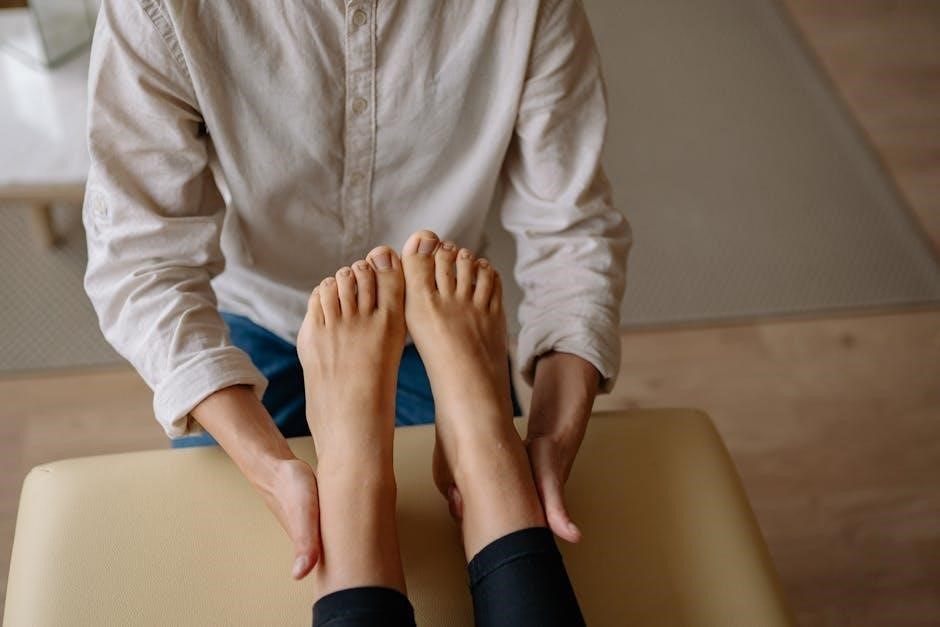
Step-by-Step Full Body Massage
A full body massage begins with preparation, ensuring the environment is comfortable and warm. Start with gentle effleurage strokes on the back to relax the muscles. Progress to petrissage on the legs and arms, followed by targeted pressure on the neck and shoulders. Use kneading techniques on the hands and feet for deep relaxation. Conclude with gentle strokes on the scalp and face. Each step should flow smoothly, maintaining consistent pressure and rhythm. This structured approach ensures comprehensive coverage, promoting relaxation, improving circulation, and relieving muscle tension effectively. Regular practice enhances technique and client comfort.
Targeted Techniques for Common Complaints
For back pain, focus on deep tissue techniques along the spine and lower back. Neck tension responds well to slow, deliberate strokes and gentle traction. Shoulder knots can be addressed with trigger point therapy, applying sustained pressure until tension releases. For headaches, soft effleurage on the scalp and temples is effective. Always adjust pressure and technique based on individual needs. Regular practice helps refine these methods, ensuring personalized relief for common discomforts. This approach enhances massage effectiveness and client satisfaction, making sessions more impactful and tailored to specific issues. Consistency is key to mastering these targeted techniques.
Chair Massage: A Convenient Option
Chair massage is a practical and accessible way to provide relief, often performed in a specially designed chair. It targets key areas like the neck, shoulders, and back, offering relaxation without requiring oils or disrobing. Sessions are typically shorter, lasting 10–30 minutes, making it ideal for busy settings. This method is especially popular in workplaces and events, promoting stress reduction and improving posture. It’s a time-efficient way to address muscle tension and enhance overall well-being, focusing on areas that commonly hold strain. Chair massage is a versatile option for both personal and professional use. Its convenience makes it a favorite for many. Regular sessions can significantly improve mental and physical health, offering a quick escape from daily stress. This technique is perfect for those seeking immediate relaxation without the need for a full-body massage. Chair massage is a simple yet effective way to recharge and maintain wellness. It’s a great introduction to massage therapy for newcomers. Many practitioners offer chair massage as a standalone service or incorporate it into larger wellness programs. Its portability and ease of use make it a valuable tool for promoting health in various environments. By focusing on high-tension areas, chair massage provides targeted relief and a sense of renewal. It’s a testament to the adaptability of massage therapy, ensuring accessibility for everyone. Chair massage is a powerful way to bring relaxation into everyday life, making it a popular choice for individuals and organizations alike. It’s a convenient solution for maintaining well-being in a fast-paced world. Chair massage is a timeless technique that continues to evolve, offering benefits for both mind and body. It’s a perfect example of how massage can be tailored to meet diverse needs and preferences. This approach ensures that everyone can enjoy the advantages of massage therapy, regardless of time or setting. Chair massage is a celebration of simplicity and effectiveness, proving that even brief sessions can have a profound impact. It’s a reminder that wellness is achievable in just a few minutes a day. Chair massage is more than a trend—it’s a sustainable way to prioritize health and happiness. Its enduring popularity speaks to its effectiveness and accessibility. Chair massage is a shining example of how massage therapy can adapt to modern lifestyles, ensuring that relaxation and relief are always within reach. It’s a gift to those seeking balance in a hectic world. Chair massage is a simple yet profound way to nurture both body and mind, offering countless benefits in a concise and convenient format. It’s a true gem in the world of massage therapy, providing comfort and rejuvenation to countless individuals. Chair massage is a timeless practice that continues to inspire and uplift, proving that even small moments of care can lead to significant positive change. It’s a beautiful blend of tradition and innovation, making wellness accessible to all. Chair massage is a powerful reminder of the importance of self-care and the transformative power of touch. It’s a celebration of health, harmony, and happiness, all within reach of a chair. Chair massage is a gift to modern society, offering solace and strength in equal measure. It’s a testament to the enduring power of massage therapy to improve lives. Chair massage is a beacon of hope for those seeking relief and renewal, proving that wellness is always attainable. It’s a shining star in the constellation of massage techniques, guiding us toward a healthier, happier future. Chair massage is a beautiful expression of care and compassion, wrapping individuals in comfort and tranquility. It’s a simple yet extraordinary way to honor the body and uplift the spirit. Chair massage is a true treasure, offering peace and rejuvenation in a world that often feels overwhelming. It’s a gentle reminder that taking care of ourselves is not just important—it’s essential. Chair massage is a delightful way to pause, breathe, and reconnect with our inner selves. It’s a loving invitation to embrace wellness and live life to the fullest. Chair massage is a precious gift, offering solace, strength, and serenity to all who experience it. It’s a heartfelt way to nurture our well-being and find balance in life’s journey. Chair massage is a radiant expression of the healing power of touch, illuminating the path to a brighter, healthier tomorrow. It’s a beautiful way to give and receive care, fostering connections and fostering well-being. Chair massage is a simple yet extraordinary practice that continues to touch hearts and minds, reminding us of the beauty of human connection. It’s a powerful symbol of the impact we can have on one another’s lives through compassion and care. Chair massage is a timeless art that transcends borders and boundaries, uniting people in their quest for health and happiness. It’s a universal language of love and support, spoken through the gentle touch of skilled hands. Chair massage is a shining example of how we can make a difference in the lives of others, one touch at a time. It’s a beautiful way to share the gift of wellness, spreading joy and comfort wherever it’s practiced. Chair massage is a celebration of life, love, and the human spirit, offering hope and healing to all it touches. It’s a profound reminder of the transformative power of compassion and the importance of caring for one another. Chair massage is a beautiful journey of discovery, growth, and renewal, guiding us toward a more fulfilling and meaningful existence. It’s a powerful tool for creating positive change, one session at a time. Chair massage is a heartfelt way to honor the beauty of life and the resilience of the human spirit. It’s a simple yet extraordinary way to make a lasting impact on the world, one touch at a time. Chair massage is a true marvel, offering solace, strength, and inspiration to all who experience it. It’s a testament to the enduring power of compassion and the transformative power of touch. Chair massage is a beautiful expression of love and care, wrapping individuals in warmth and comfort. It’s a shining example of how we can make a difference in the lives of others, one gentle touch at a time. Chair massage is a timeless practice that continues to inspire and uplift, proving that even the smallest acts of kindness can have a profound impact. It’s a celebration of the human spirit and the power of connection, offering hope and healing to all it touches. Chair massage is a beautiful way to nurture both body and mind, providing comfort, strength, and renewal. It’s a heartfelt way to honor the importance of self-care and the transformative power of touch. Chair massage is a precious gift, offering solace, serenity, and inspiration to all who experience it. It’s a simple yet extraordinary way to improve lives and create a more compassionate world, one touch at a time. Chair massage is a shining star in the constellation of wellness practices, guiding us toward a brighter, healthier future; It’s a powerful reminder of the importance of caring for ourselves and others, and the profound impact that touch can have on our lives. Chair massage is a beautiful expression of love and support, offering comfort, strength, and renewal to all it touches. It’s a timeless practice that continues to inspire and uplift, proving that even the smallest moments of care can lead to significant positive change. Chair massage is a true treasure, offering peace, tranquility, and inspiration to all who experience it. It’s a heartfelt way to honor the body and uplift the spirit, providing a much-needed respite from the challenges of everyday life. Chair massage is a simple yet extraordinary way to nurture our well-being and find balance in life’s journey. It’s a loving invitation to embrace wellness and live life to the fullest, surrounded by the comfort and support of compassionate care. Chair massage is a precious gift, offering solace, strength, and serenity to all who experience it. It’s a beautiful way to give and receive care, fostering connections and fostering well-being in a world that often feels overwhelming. Chair massage is a radiant expression of the healing power of touch, illuminating the path to a brighter, healthier tomorrow. It’s a powerful symbol of the impact we can have on one another’s lives through compassion and care. Chair massage is a timeless art that transcends borders and boundaries, uniting people in their quest for health and happiness. It’s a universal language of love and support, spoken through the gentle touch of skilled hands. Chair massage is a shining example of how we can make a difference in the lives of others, one touch at a time. It’s a beautiful way to share the gift of wellness, spreading joy and
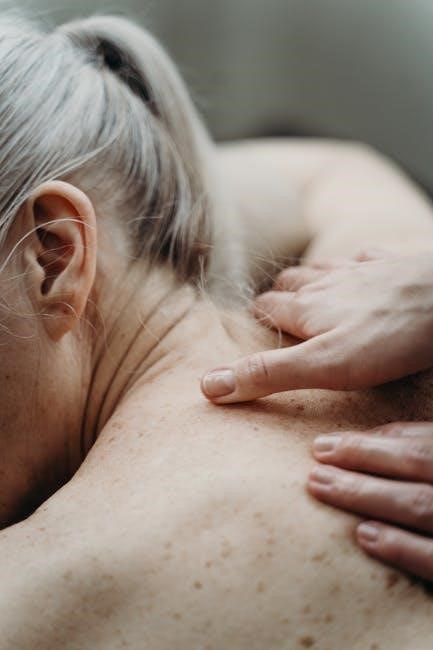
Advanced Techniques and Variations
Advanced techniques blend creativity with precision, combining Swedish and deep tissue methods. Incorporating tools enhances effectiveness, offering deeper relaxation and muscle relief.
Combining Swedish and Deep Tissue Techniques
Blending Swedish massage’s flowing strokes with deep tissue’s targeted pressure creates a balanced approach. This fusion addresses both superficial relaxation and deeper muscle tension. By integrating long, gliding effleurage strokes with precise, focused kneading, therapists can tailor sessions to individual needs. This hybrid method promotes circulation, eases chronic pain, and enhances flexibility. It’s particularly effective for clients seeking both relaxation and therapeutic relief, offering a holistic experience that caters to diverse muscle groups and discomfort levels.
Incorporating Thai Massage Principles
Thai massage combines acupressure, assisted yoga stretches, and rhythmic pressure to create a dynamic, holistic experience. By incorporating these principles, practitioners can enhance flexibility, balance energy flow, and deepen relaxation. Techniques like sen energy line work and gentle stretching improve range of motion and reduce muscle tension. This approach complements basic massage strokes, offering a unique blend of physical and therapeutic benefits. It’s an excellent way to add variety and depth to massage routines, promoting overall well-being and body alignment.
Using Massage Tools and Accessories
Massage tools and accessories can enhance therapy effectiveness and client comfort. Tools like foam rollers, massage stones, and balls target specific areas, reducing hand strain. Hot stones provide soothing heat, while cold stones aid inflammation. Accessories such as bolsters and pillows support proper body positioning. Oils and lotions reduce friction, improving glide. Incorporating these tools allows therapists to offer diverse techniques, tailoring sessions to individual needs. They expand the therapist’s capabilities, making massage more versatile and beneficial for clients.
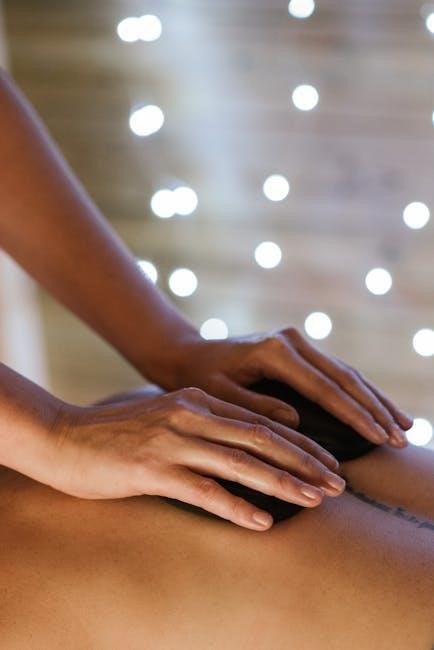
Mental and Emotional Benefits
Massage enhances mental well-being by reducing stress, anxiety, and depression. It promotes relaxation, improves mood, and fosters emotional balance, leading to a calmer and more centered mind.
Massage for Anxiety and Depression
Massage therapy offers significant benefits for managing anxiety and depression by promoting relaxation and reducing stress. Techniques like effleurage and petrissage help calm the nervous system, lowering cortisol levels and improving mood. Regular massage can enhance serotonin and dopamine production, alleviating symptoms of depression. The therapeutic touch fosters emotional connection and comfort, providing relief from feelings of isolation. By addressing both physical tension and emotional distress, massage becomes a holistic approach to supporting mental health and well-being.
Enhancing Relaxation and Sleep Quality
Massage therapy is a powerful tool for enhancing relaxation and improving sleep quality. Gentle strokes, such as effleurage, calm the nervous system, reducing stress and promoting a deep sense of calm. Regular massage can lower cortisol levels, helping the body unwind and prepare for restful sleep. Techniques that target tense muscles and improve circulation further support relaxation, making it easier to fall asleep and stay asleep. By incorporating massage into a bedtime routine, individuals can achieve a more restful and rejuvenating sleep experience, enhancing overall well-being.
Boosting Overall Well-Being
Massage therapy plays a significant role in enhancing overall well-being by addressing both physical and emotional health. Techniques like effleurage and petrissage improve circulation, reducing muscle tension and promoting a sense of balance. Regular massage can also boost mood by releasing endorphins, which combat stress and anxiety. Additionally, it strengthens the immune system and improves posture, contributing to a healthier lifestyle. By incorporating massage into daily or weekly routines, individuals can experience long-term benefits, fostering a state of holistic well-being and vitality that enriches their quality of life and overall happiness.
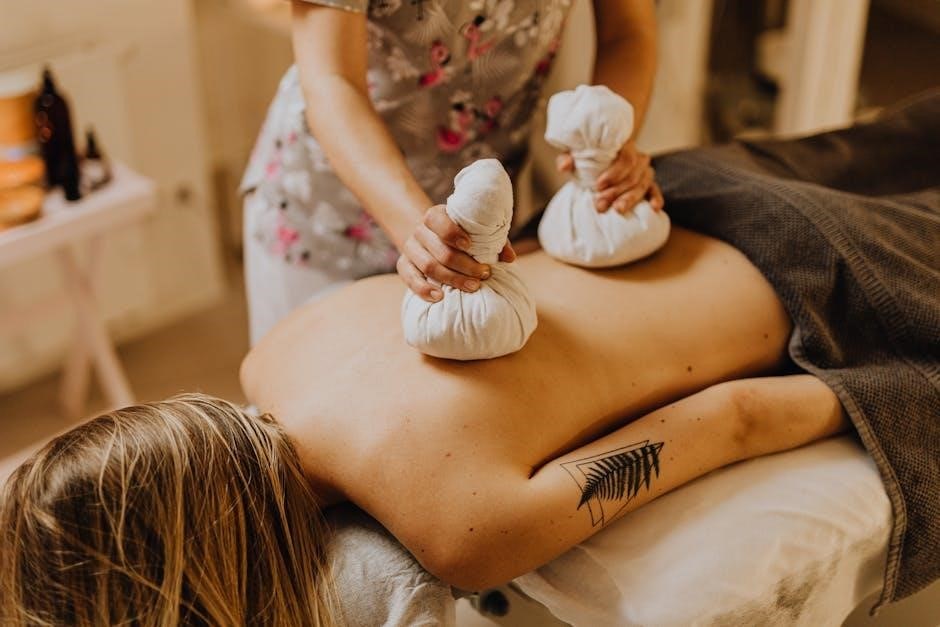
Resources and Further Learning
Explore comprehensive guides, online courses, and professional certifications to effectively deepen your understanding and mastery of basic massage techniques for enhanced practice and skill development.
